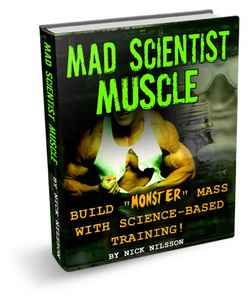Nick Nilsson is an experienced weight lifter with a degree in physical education and psychology. He’s also a personal trainer and an author, having written three different books on the topic of weight training. I recently had the opportunity to review his work Mad Scientist Muscle: Build monster mass with science-based training.
Wow, Nick has really taken the time to put together a complete program. This isn’t some hastily-thrown together work by someone who is out to make a quick buck. Nope. This is a well-done work put together by someone who really knows his stuff. Let’s take a look.
The Mad Scientist program is based on two principles:
1) Planned overtraining and rebound; and
2) Training to change your physiology to better support muscle growth.
The first principle has actually been around for a quite awhile, but you may know it under another name—Accumulation and Intensification.
The second principle addresses the body’s physiology. There are some things you can’t really change—like your basic genetic and hormonal makeup—but some things you can. There are also things that while you can’t change them, you certainly can influence them for your benefit. This principle helps you to identify and influence all the factors in your training that can actually change your base physiology to make it more favorable to muscle growth.
The Mad Scientist approach includes three elements: the program; exercise and nutrition. The program itself is the entire training system and the four two-month cycles that comprise it. The first cycle focuses on time/volume training, the second cycle focuses on cluster training, the third cycle is focused on rest-pause training and the fourth cycle is for advanced trainers only and is known as the “Frankenstein” cycle.
The exercise component is of course the training techniques for building muscle and lastly, the nutrition component lays out the nutritional roadmap for ‘eating for mass.’
The first section of the book provides information about the different approaches to exercises that Nick uses in the Mad Scientist program. Basically what he does in this part of the book is to explain in detail 13 different approaches to exercise that make up the Mad Scientist approach.

For example, he opens with a discussion about how you can use controlled overtraining to your advantage by pushing yourself just to point of approaching overtraining and then switching to an intensification period where you back off. As you go through these sections it becomes apparent that Nick has spent a lot of time researching the techniques and strategies he’s presenting. What you get with each section is a description of the philosophy, the training techniques it embodies, the how and why of the approach and benefits you can expect from using it.
The next section of the book is all about nutrition. He starts this section off with his three basic rules for eating for mass:
1) eat plenty of calories;
2) eat plenty of protein; and
3) eat good quality food and drink a lot of water.
The nutrition part of the book is broken down into nine different sections: meal plans; caloric intake; frequently asked questions about protein; meal timing; low carb eating option; supplements; pre- and post-workout nutrition; Nick’s ‘Lazy Cook’ muscle-building recipes; and eating clean.
In the next section of the book Nick provides the details about each cycle of the program. During each week, you spend four days training with the remaining days being open for rest or for cardio. For these sections charts lay out the body parts, the exercises, the proper number of sets and reps as well as some notes from Nick for each one. The format is basically the same until you get to the “Frankenstein” section, where—if you can handle it—you begin really intense workouts six days a week. This entire part of the books is a couple hundred pages long, so believe me you won’t be getting bored any time soon.
 For the very last section of the book, Nick closes with a very handy ‘carb counter’ for all kinds of different foods, snacks, beverages and even alcoholic beverages. It’s really very handy. It includes most common foods and beverages you’re likely to run across and provides information about serving size, the amount of carbohydrates and the amount of dietary fiber in each.
For the very last section of the book, Nick closes with a very handy ‘carb counter’ for all kinds of different foods, snacks, beverages and even alcoholic beverages. It’s really very handy. It includes most common foods and beverages you’re likely to run across and provides information about serving size, the amount of carbohydrates and the amount of dietary fiber in each.
I can say that I really like the ideas and concepts Nick presents in Mad Scientist Muscle. It’s apparent that he’s a smart guy who not only knows what he’s talking about, but he’s also able to present the information in an engaging, easy-to-follow format that allows anyone who has got the willingness, guts and discipline to follow through with his suggestions, to achieve amazing results.
If you think Nick is a genetic freak check out some pics from his site where you can see that he has come a long way having gained more than 75 lbs of muscle. It’s a funny story actually, you should check it out over at http://www.madscientistmuscles.com






























